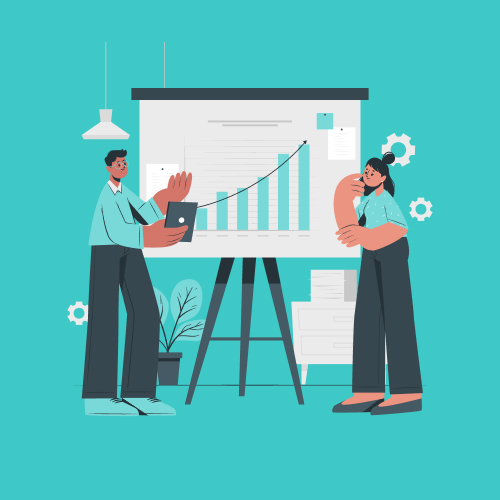In today’s fast-paced business environment, utilising HR people analytics has become crucial for organisations striving to remain competitive.
As companies face a constantly evolving workforce landscape, the ability to make informed decisions based on data-driven insights is becoming not only valuable but essential.
What is HR people analytics?
HR people analytics refers to the method of collecting and analysing employee data to boost performance, streamline processes, and enhance decision-making functions within Human Resources (HR).
By transforming raw data into actionable insights, organisations can delve deeper into workforce dynamics, identify trends, and anticipate potential challenges.
This analytical approach focuses on metrics that matter – key performance indicators (KPIs) such as employee engagement, retention rates, and recruitment efficiency.
The evolution of HR analytics

Historically, HR management relied heavily on manual processes and intuition to make staffing decisions. However, the landscape has shifted dramatically with improvements in data collection technologies and analytical tools. Today’s advanced HR analytics systems harness the power of AI and machine learning to offer predictive insights, optimising every facet of HR management from recruitment to retention.
The importance of people analytics in HR is underscored by the fact that only about 10% of companies can effectively correlate HR data with business outcomes, according to research. This gap represents a massive opportunity for HR leaders willing to embrace data-driven strategies.
By adopting human capital analytics, organisations can transcend traditional practices and align workforce objectives with strategic business goals.
Additionally, the implementation of comprehensive HR platforms like MiHCM’s suite of products empowers businesses to harness these insights effectively.
Features such as predictive analytics, demographic insights, and workforce performance management are seamlessly integrated, supporting better strategic decision-making and ultimately enhancing productivity.
To truly transform your workplace with HR analytics, understanding and implementing the right tools and methodologies is key. Effective people analytics in HR not only enhances recruitment processes and talent management but also significantly impacts overall organisational efficiency.
This ultimate guide serves to navigate the complex yet rewarding journey of integrating analytics into HR functions, providing a roadmap for building a data-savvy workforce strategy.
Data sources in people analytics
People analytics in HR relies heavily on a rich tapestry of data sources to provide comprehensive insights into workforce dynamics.
Key sources include employee performance records, engagement and satisfaction surveys, HRIS (Human Resource Information Systems), and even external databases providing industry benchmarks.
Mining these data effectively requires integration across various systems – often a challenge due to data fragmentation and lack of standardised metrics. By leveraging AI-driven HR analytics for better decision-making, organisations can unify these disparate data streams into a coherent whole, making processes more efficient and insightful.
MiHCM’s suite, including MiHCM Lite and MiHCM Enterprise, provides robust analytics platforms that allow HR professionals to analyse employee demographics, performance metrics, and turnover rates with ease. These solutions enhance recruitment, foster a diverse workforce, and ultimately streamline HR work.
Role of technology in streamlining data processes

Technology plays an indispensable role in streamlining the complexities of HR people analytics. AI and machine learning pave the way for reduced manual intervention and enhanced predictive capabilities.
For example, features like MiHCM Data & AI transform people data into gold by revealing patterns in diversity, productivity, and leave usage. Notably, AI can greatly reduce human bias in HR decisions, offering a more objective lens through which to evaluate talent.
- Efficient recruitment: AI-driven systems can swiftly analyse resumes and video interviews, predicting candidate success with greater accuracy than traditional methods.
- Enhanced team productivity: Through data-driven insights, AI helps managers pinpoint areas for team performance improvements and career development.
- Streamlined HR work: AI tools expedite routine tasks and enable HR to focus on strategic initiatives that enhance business impact positively.
By adopting these technologies, HR departments can navigate the complexities of big data integration, offering not just superior workforce insights but also fostering a culture of data-driven decision-making.
The transformative potential of people analytics in HR is vast, driven by the synergistic integration of advanced tools and AI technology.
Understanding workforce dynamics
Unlocking the full potential of HR People Analytics requires an intricate understanding of workforce dynamics. This entails going beyond superficial observations to delve into core metrics that drive your company’s success.
Essential metrics include employee engagement levels, retention rates, recruitment efficiency, and productivity measures. Understanding these metrics provides actionable insights into your workforce’s behaviour, enabling strategic decision-making that’s crucial for business growth.
Organisations focused on human capital analytics can achieve a competitive edge by transforming collected data into valuable insights that inform HR strategies.
For example, metrics around retention can signal potential turnover risks, whereas productivity data can highlight areas requiring operational improvements. By recognising trends in these areas, HR departments can proactively implement changes that enhance company performance and employee satisfaction.
Metrics that matter

When it comes to people analytics in HR, certain metrics stand out in significance:
- Employee engagement: Determine how engaged your workforce is through surveys and feedback mechanisms and make informed decisions aimed at improving employee satisfaction.
- Turnover rates: Monitor your turnover rates to identify patterns and potential ‘at-risk’ employees, a practice crucial for managing turnover efficiently.
- Time-to-fill: Measure recruitment efficiency by evaluating the average time required to fill open positions. This metric indicates the effectiveness of your recruitment processes.
- Employee productivity: Analyse timesheets, work hours, and overtime metrics for workforce productivity analysis. Platforms like MiHCM provide detailed insights that are instrumental in identifying performance gaps and boosting productivity.
- Diversity metrics: Maintain a broad range of perspectives and backgrounds by analysing diversity rates. Building a diverse workforce is not just a regulatory requirement but also a competitive advantage.
HR analytics for better decision-making
The impact of HR analytics for better decision-making lies in identifying trends and patterns through these key metrics.
This enables managers to predict workforce performance and unlock workforce productivity, thereby transforming the overall efficiency of your HR operations.
Simultaneously, through predictive analytics incorporated in tools provided by MiHCM, businesses can enhance recruitment processes and improve recruitment efficiency.
By focusing on metrics that matter, HR departments not only improve efficiency and performance but also build a resilient organisation capable of navigating future challenges effectively.
Laying the foundation
Implementing HR people analytics effectively requires a structured approach. The foundation of successful analytics implementation lies in clear strategy and goals.
Begin by identifying key objectives that align with your organisation’s strategic targets, such as improving recruitment efficiency or enhancing employee engagement.
Engage with stakeholders from various departments to ensure that your analytics initiative has broad support and is driven by real business needs.
A crucial step in laying the groundwork is data management. Ensure that data sources are well-integrated and that data is both accessible and reliable. This involves selecting appropriate tools that can handle data integration and provide comprehensive analytics capabilities.
Advanced solutions like MiHCM’s suite offer features that facilitate data amalgamation, transforming raw data into actionable insights that support strategic decision-making.
Set up a phased rollout plan, beginning with pilot projects that focus on specific metrics or areas, allowing your team to customise processes and adjust methodologies based on initial findings. This iterative process helps in refining data models and fostering a data-centric culture within the organisation.
Engagement and adoption
For people analytics in HR to drive meaningful change, it must be integrated into organisational culture.
Leadership involvement is pivotal. Leaders must advocate for data-driven decision-making and personalise communications to show the tangible benefits of analytics integration across different business areas.
Train HR teams and managers to interpret and utilise analytics findings effectively. Hosting regular training sessions or workshops will ensure that staff are comfortable with the tools and understand how to use data insights to make informed decisions. Consider offering an HR analytics course to help build competencies in data analysis and interpretation.
Encourage transparency in communicating analytics findings and related decisions. Regular updates and insights can be shared company-wide through newsletters or dashboards to keep all departments informed. Such transparency enhances organisational alignment around shared objectives and bolsters trust in HR analytics processes.
Incentivise data engagement by celebrating early successes. Highlighting case studies of departmental improvements driven by insights can boost morale and demonstrate the concrete impact of analytics projects.
Address common pitfalls by being aware of potential resistance to change. Tackle this by clearly articulating the value proposition of HR people analytics, emphasising benefits such as smarter spending decisions, improved recruitment efficiency, and enhanced employee engagement.
Offer regular opportunities for feedback to refine the process continually and ensure the system works for everyone involved.
Done right, implementing HR people analytics can transform the organisational approach to workforce management, drive better HR decisions, and ultimately uplift overall productivity and engagement.
With a structured implementation plan and strong stakeholder involvement, your organisation can reap the benefits of people analytics, setting the stage for continuous improvement and strategic success.
Overcoming challenges in implementation
Implementing HR people analytics poses several challenges that require strategic solutions. Addressing these issues head-on is crucial to unlocking the full potential of people analytics in hr. Here we explore common hurdles and present actionable solutions:
- Data fragmentation: One of the most significant obstacles is fragmented data spread across various platforms and systems. This can hinder comprehensive analysis and insight generation. A solution lies in implementing integrated HR systems that centralise data sources, enabling cohesive data management and simplifying correlation with business metrics.
- Poor data definition: Inconsistent data definitions across systems can lead to inaccuracies and misinterpretations. Establishing standardised terms and clear data definitions across the organisation fosters consistency and enhances the reliability of hr analytics.
- Lack of system integration: Disparate systems that don’t communicate effectively can create silos, obstructing data access. Solutions involve integrating HRIS with business intelligence tools, ensuring seamless data flow and comprehensive analysis capabilities.
AI’s role in simplifying HR analytics
Artificial Intelligence has emerged as a pivotal ally in overcoming these challenges:
- Data management efficiency: AI reduces the time and effort spent on data cleaning and modelling, allowing HR teams to focus on deriving strategic insights. Tools such as MiHCM Data & AI illustrate AI’s capacity to streamline analytics and enhance data-driven HR decisions.
- Bias reduction: AI systems analyse data without human prejudice, providing more objective insights. By identifying patterns of bias within recruitment and performance reviews, AI helps improve decision fairness.
- Real-time insights: AI-powered tools enable real-time data analyses, helping HR departments quickly react to emerging trends and issues. This capability is crucial for strategic workforce planning and improving hr efficiency.
Navigating Common Challenges
Here’s a checklist to help overcome common challenges in implementing people analytics in HR:
- Conduct comprehensive data audits to understand integration needs
- Define standardised data metrics and terminologies
- Invest in integrated technology platforms for seamless data flow
- Leverage AI tools, like those from MiHCM, to streamline analysis
- Establish strong internal communication channels for data insights
Preparing for the future
The future of HR people analytics is set to be increasingly intertwined with advances in AI and automation technologies. As businesses strive to keep up with rapid changes, the ability to harness these trends will be key in maintaining competitiveness.
One emerging trend is the use of advanced AI analytics to transform raw data into predictive models that anticipate workforce changes. This allows companies to predict potential turnover risks, identify employee satisfaction levels, and prepare for market-driven shifts that impact talent management.
With AI’s capability to analyse large datasets quickly, HR departments can efficiently develop strategies that respond to these insights, leading to a more agile workforce.
Automation is another driving force in the evolution of people analytics in HR. Automated systems streamline routine HR tasks, such as benefits administration and employee onboarding, freeing up HR professionals to focus on strategic initiatives.
This shift enables more personalised employee interactions, improving engagement and retention by addressing individual needs quicker and more effectively.
Furthermore, the increasing prevalence of mobile platforms offers HR new ways to track and manage employees remotely. With mobile attendance tracking and remote workforce management tools, organisations can maintain flexibility while ensuring oversight and productivity.
These platforms also allow for greater transparency and connectivity, building a culture of trust and collaboration across geographies.
By staying ahead of these innovations, HR can lead the charge in creating adaptable, resilient organisations ready to face future challenges.



